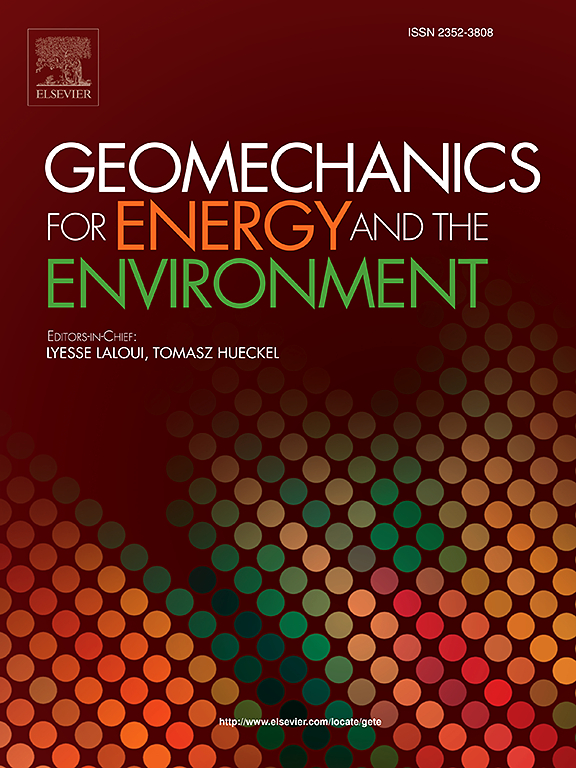Erosion mechanism of subsea tunnel considering non-linear seepage and linearly varying permeability coefficient with time
IF 3.7
2区 工程技术
Q3 ENERGY & FUELS
引用次数: 0
Abstract
The erosion mechanism of the subsea tunnel is complicated due to the unique submarine environment. Most research assumes the fluid follows Darcy's law and neglects the increasing permeability coefficient of the grouting zone with continuous chloride ion erosion. However, the grouting and lining zones exhibit relatively high density, causing the deviation of flow seepage from Darcy's law to non-Darcy's law. This paper aims to accurately study the erosion mechanism under non-Darcy seepage condition using Hansbo's non-linear seepage model. The entire erosion process is divided into three stages: (a) initial erosion, (b) developed erosion, and (c) rapid erosion. The focus is on investigating the erosion mechanism during the developed erosion stage, in which the grouting zone follows the linear segment of Hansbo's non-linear seepage law and the lining zone follows the curved segment under relatively high-water levels. The analytical solutions for the erosion depth and ion concentration are obtained, considering the linearly varying permeability coefficient of the grouting zone over time. Our proposed method is validated through the numerical simulation and established solution. In addition, parametric analyses are conducted including the service time and change of the permeability coefficient. It reveals that the pore pressure and erosion depth at different locations of the grouting zone increase approximately linearly as the water head acting on the ground surface increases. The erosion depth and ion concentration increase with the service time, with the most significant impact observed at the tunnel invert. A greater impact on the concentration is found closer to the surface of the grouting zone. The erosion depth is deeper considering the linearly varying permeability coefficient rather than a constant. However, the influence on ion concentration is minimal.
考虑非线性渗流和渗透系数随时间线性变化的海底隧道侵蚀机理
由于独特的海底环境,海底隧道的侵蚀机理十分复杂。大多数研究假设流体遵循达西定律,忽略了氯离子持续侵蚀灌浆区渗透系数的增加。但注浆区和衬砌区密度较大,导致渗流从达西定律向非达西定律偏离。本文旨在利用Hansbo非线性渗流模型准确研究非达西渗流条件下的侵蚀机理。整个侵蚀过程可分为三个阶段:(a)初始侵蚀,(b)发育侵蚀和(c)快速侵蚀。重点研究了高水位条件下,发育侵蚀阶段注浆区遵循Hansbo非线性渗流规律的线段,衬砌区遵循曲线段的侵蚀机理。考虑灌浆区渗透系数随时间的线性变化,得到了侵蚀深度和离子浓度的解析解。通过数值模拟和建立的解验证了所提方法的有效性。此外,还进行了服役时间、渗透系数变化等参数分析。结果表明:注浆区不同位置的孔隙压力和侵蚀深度随着地表水头的增大而近似线性增大;随着使用时间的延长,侵蚀深度和离子浓度增加,其中对隧道仰拱的影响最为显著。靠近注浆区表面对浓度的影响更大。考虑线性变化的渗透系数而不是常数时,侵蚀深度更深。然而,对离子浓度的影响很小。
本文章由计算机程序翻译,如有差异,请以英文原文为准。
求助全文
约1分钟内获得全文
求助全文
来源期刊

Geomechanics for Energy and the Environment
Earth and Planetary Sciences-Geotechnical Engineering and Engineering Geology
CiteScore
5.90
自引率
11.80%
发文量
87
期刊介绍:
The aim of the Journal is to publish research results of the highest quality and of lasting importance on the subject of geomechanics, with the focus on applications to geological energy production and storage, and the interaction of soils and rocks with the natural and engineered environment. Special attention is given to concepts and developments of new energy geotechnologies that comprise intrinsic mechanisms protecting the environment against a potential engineering induced damage, hence warranting sustainable usage of energy resources.
The scope of the journal is broad, including fundamental concepts in geomechanics and mechanics of porous media, the experiments and analysis of novel phenomena and applications. Of special interest are issues resulting from coupling of particular physics, chemistry and biology of external forcings, as well as of pore fluid/gas and minerals to the solid mechanics of the medium skeleton and pore fluid mechanics. The multi-scale and inter-scale interactions between the phenomena and the behavior representations are also of particular interest. Contributions to general theoretical approach to these issues, but of potential reference to geomechanics in its context of energy and the environment are also most welcome.
 求助内容:
求助内容: 应助结果提醒方式:
应助结果提醒方式:


